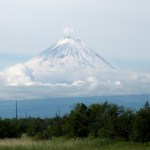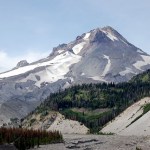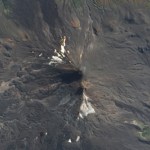lava flows
There are a couple article out today concerning volcanoes and the economy, one on the plus side, one on the minus side.
Volcano Buono in Italy near Naples.
First off, nothing like volcanism to get me stoked for buying stuff, eh? Actually, I have to admit, the Volcano Buono mall (yes, mall) in Italy near Naples (and yes, near Vesuvius) is one of the rather more attractive malls I've seen in a long time (above). It is designed to look like a volcano - I suppose it looks most like a monogenetic scoria cone, a little out of place for that part of Italy - but its design was based on trying use…
Busy today with scouting out some field location for the class I'll be teaching this fall. Here's this week's USGS/SI Weekly Volcano Report. The report is a little more eventful than last week's, so enjoy!
Kliuchevskoi Volcano in Kamchatka, taken summer of 2009 by Theresa Kayzar.
Highlights include:
Three volcanoes on the Kamchatka Peninsula are currently producing ash plumes: Kliuchevskoi, Koryaksky and Shiveluch. Shiveluch has been having the most intense eruptions, but the former two are both producing ash-and-steam plumes that reach over 3 km / 10,000 feet.
Talang in Indonesia saws its…
The Royal Gardens subdivision in Hawai'i being inundated with lava flows during a 1983 eruption of Kilauea. Image courtesy of the USGS.
The game of insurance is everywhere in the news these days so it isn't too surprising to run across this brief article about the perils of getting insured if you live on an active volcano. Many people who live on the big island of Hawai'i face this challenge because a large swaths of the island fall into what is called a "Lava Zone 1", which more or less means that you live someplace that lava is likely to visit in the foreseeable future. Considering that…
Again, sorry about the paucity of posts. Getting prepared to move 3/4 of the way across a continent will do that. Look for the next Volcano Profile, this time for Erebus in Antarctica, to be posted sometime in the next week or so.
We did get some news over the weekend of a large eruption at Shiveluch. The volcano in Kamchatka has been active all summer, but on Saturday it produced a 5,000 meter / ~23,000 foot ash plume. This was accompanied by 170 earthquakes and multiple avalanches, likely produced by the collapsing dome on the summit of the volcano. There is a little more information about…
Sorry about the lack of posts - the holiday and "real life" had stepped in the way.
On with the news!
Mayon Volcano in the Philippines with Legazpi City in the foreground.
Mayon, one of the most active volcanoes in the Philippines, is causing concern due to increasing signs of activity. Renato Solidum, the director of PHIVOLCS (Philippine Institute of Volcanology and Seismology), said that there has been increasing seismic activity and "glow" at the summit of the volcano near (~20 miles / 45 km) Legazpi City. However, even after this sense of increasing activity, the alert level (1) has not…
We've already talked about how many active volcanoes reside in Indonesia, but this week's USGS/SI update just drives that point home. Listed in the update are no less than 5 volcanoes were activity is being seen or is on the increase (Karangetang, Slamet, Dukono, Batu Tara and Makian). This doesn't mean mention the activity at Anak Krakatau, Rinjani or Semeru. Amazing.
Anyway, highlights - not counting Indonesia or the South American trio - from this week's report (as usual aptly put together by Sally Kuhn Sennert) include:
A ~8,000 foot / 2.4 km ash and steam plume from Bagana in Papua New…
Your weekly dose of volcanic activity from the USGS/SI. (a little late thanks to an exciting day of column chemistry).
Some highlights include:
A 3.7 km / 12,000 foot ash plume from Karangetang in Indonesia (great name, eh?)
Lava flows, ash plumes and local ash falls from Slamet in Indonesia.
White and grey ash plumes rises to ~4 km / 13,000 feet from Colima, Mexico.
Blocks up to 2-m across were transported by lahars from Fuego in Guatemala. The volcano also produced ~4.6 km / 14,500 foot ash plumes.
Small ash plume spotted at Barren Island in the Andaman Islands of India.
Things are busy - both volcanically and personally - so I'm going to just give you some links to a bunch of exciting/interesting/insane news:
West Mata erupting on May 5, 2009 in the Lau Basin.
According to a bunch of news sources, the eruption at Fernandina in the Galapagos is over (in spanish). That being said, the PNG noted that there is still a lot of carbon dioxide and sulfur dioxide being emitted, suggesting there is still a lot of degassing magma beneath the vents - at what depth (and will it erupt) is the question.
There is a lot of speculation that Nyiragongo (DRC) is erupting or…
Back in the days when Eruptions was on Wordpress, I held a vote about what volcano should be the next to be profiled on this blog. The winner was Mt. Hood in Oregon, and after much waiting, the profile is here. I will actually be out of town until Monday doing some house shopping in this little town. Enjoy this look at one of the most picturesque (and hazardous - #4 in fact) volcanoes in the lower 48 states.
VOLCANO PROFILE: MT. HOOD
Mt. Hood, Oregon in August 2008 taken by Erik Klemetti.
Location: Oregon, U.S.A.
Height: 3,426 m / 11,240 ft
Geophysical location: Along the Cascade arc where…
UPDATED 3:30PM Pacific: The Associated Press has put up some silent video of the lava flows reaching the ocean at night
The Geophysical Institute in Ecuador is reporting that the eruption at Fernandina in the Galapagos has intensified over the last 24 hours. Heck, the image accompanying the report looks downright apocalyptic:
Now, I'm actually not entirely sure what is being shown in this image. There is no caption, either. My guess is that this is an ocean entry for one of the lava flows, considering the steam and what looks to be water in the foreground. Of course, I have no idea if the…
Fernandina in the Galapagos erupting in April 2009. Image courtesy of NASA.
The latest reports about the ongoing eruption at Fernandina are both coming and going. Reports from officials in the Galapagos National Park suggest that the eruption was become more intense (in spanish), while later reports from the Geophysical Institute in Ecuador say that the eruption is waning. Both reports might be true and reflect the volatile nature of the eruption, but overall it seems that the wildlife (that probably is used to this sort of thing anyway) hasn't been effected too much by the eruption.
It has been rather quiet on the volcano-front in the last week. Redoubt and Llaima (in spanish), after a few weeks of intense eruption, are both back on Orange Alert. News of the eruptions from Hunga Tonga Hunga Ha'apai and Fernandina is rather sparse in the details. The news of volcanism in 2009 seems to have settled down.
A few tidbits I caught over the weekend:
Chaiten
Damage wrought by the eruption of Chaiten on the town of Chaiten in Chile, taken in early December 2008. Image courtesy of the NASA Earth Observatory.
Don't you feel like you're read this sort of story before after other…
The weekend is rolling in and I might end up spending most of it in the 90+ degree California weather, so unless something big comes up (volcanically), I'll leave you with a few news bits.
Llaima
Llaima in April 2009. Image courtesy of the NASA Earth Observatory
This is a true color image of Llaima in Chile, provided by the great folks at the NASA Earth Observatory. You can clearly see the dark grey new tephra on the main summit cone along with the grey ash covering the snow on the southwestern part of the volcano (north is up). A few other fun features are some smaller parasitic cones in…
Fissure vent eruption from Fernandina in the Galapagos Islands.
In news that comes as a surprise to no one, the current eruption on Fernandina in the Galapagos is having some adverse effect on the wildlife in the Pacific archipelago. Numerous dead fish and sea lions have been seen in the ocean near the actively erupting volcano - now, what exactly is causing the deaths is more speculative. I would imagine with the large plume being produced by the volcano, along with the lava flows reaching the ocean, that volcanic gases and the lava's interaction with the sea water might be the leading…
Fernandina, Ecuador
Fernandina erupting in 2009.
UPDATE 4/13/09 at 12PM: The NASA Earth Observatory has posted a nice MODIS image showing the plume from the Fernandina eruption drifting out over the Pacific.
We have a few more details on the ongoing eruption at Fernandina in the Galapagos Islands. Officials from the Parque Nacional Galápagos (PNG) flew over the island (in spanish) and saw the eruption is coming from a several-kilometer-long fissure vent that flows towards the sea, dividing into multiple flows and then coalescing when it reaches the sea. There is also a lot of vapor being…
Llaima erupting at night in April 2009.
Brief update for those of you following the somewhat spectacular eruption (above and below) going on at Llaima in Chile. The latest reports indicate the eruption is waning (in spanish) with less ash and explosions (in spanish) being produced. However, ONEMI, the Chilean Emergency Office, continues to keep the area on alert. So far, at least 81 people have been evacuated (in spanish) during the eruptions that gained strength over the weekend and flights between Buenos Aires and Neuquén were suspended due to the ash.
It is interesting to note the…
Mauna Loa fire fountains in 1984
For those of you looking for some non-Redoubt-related volcano news, you can take a look at the 25th anniversary of the last eruption at Mauna Loa (there is some nice video footage provided by KHNL if you follow the link). By no means is this volcano "dormant", but rather this is a typical lull in activity at the Hawaiian shield volcano. Its neighbor, Kilauea, has been erupting for decades, but the last major eruption at Mauna Loa was in 1984, when the volcano sent lava downslope with 3,000 feet of Hilo, moving 15 miles in a few days. Monitoring at Mauna Loa…


